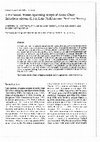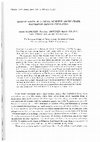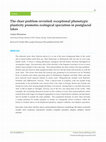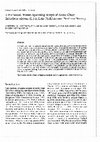Papers by Anders Klemetsen
Fisheries Research, 2005
Spatial and temporal migratory behaviour of wild Atlantic salmon smolt (Salmo salar L.) was inves... more Spatial and temporal migratory behaviour of wild Atlantic salmon smolt (Salmo salar L.) was investigated at the River Utsjoki, a tributary of the sub-Arctic River Tana, using submerged video cameras that covered the entire water column across the river. The matrix of cameras provided information on the exact time, position in water column, and swimming direction of individual smolts. The smolt migration started in the beginning of June and ended in the middle of July, i.e. during the period of midnight sun. In contrast to most other studies, smolts migrated all day, with a peak from 07:00 to 10:00 h. Hours of sunshine and change in water level explained 55% of day-to-day variation in numbers of migrating smolts. Most smolts migrated actively (head first) in lower part of the water column with only 4% observed in the upper 30 cm surface water layer.
Polar Biology, 1987
... Atlantic Salmon S. salar L. off Sen]a, N. Norway ... The diet overlap index a is given as: ) ... more ... Atlantic Salmon S. salar L. off Sen]a, N. Norway ... The diet overlap index a is given as: ) a = 1--0.5 ]Pxi-Pyi i 1 where Pxi is the proportion of prey item i in the diet of predator species x and Pyl is the proportion of prey item i in the diet of predator y. Regressions and analysis of ...

A dwarf charr that is remarkably distinct from the normal charr morph was recently discovered in ... more A dwarf charr that is remarkably distinct from the normal charr morph was recently discovered in the subarctic lake Fjellfrøsvatn, in northern Norway. It spends its entire life cycle in deep water and spawns under a thick cover of snow and ice. There is no size overlap between sexu ally mature fish of the two morphs (8-13 cm FL versus >16 cm), and their morphologies and coloration are different. Their ecological niches are very distinct. The normal charr spawns in September, and the dwarf charr spawns four months later, in February. Their spawning areas are widely separated horizontally, and the dwarf charr spawns at a depth of 30 m, while the normal charr spawns above a depth of 5 m. Their general habitats are also well segregated because the normal morph is chiefly littoral and epipelagic while the dwarf charr never seems to leave the deep benthic areas. A slight overlap in their habitats occurs in summer and early autumn, when a few normal charr were found in the profundal. The allele frequencies at the EST-2 and MDH-4,5 loci did not differ between morphs. We tentatively conclude that this is a case of sympatric splitting. Only normal charr were probably transferred to the nearby Lake Takvatn in the 1930s.
Polar Research, Jan 12, 1997
Size, age and spawning frequency of landlocked arctic charr Salvelinus alpinus (L.) in Svartvatne... more Size, age and spawning frequency of landlocked arctic charr Salvelinus alpinus (L.) in Svartvatnet, Svalbard NILS GULLESTAD and ANDERS KLEMETSEN Gullestad, N. 62 Klemetsen, A. 1997. Size, age and spawning frequency of landlocked arctic charr Salvelinus alpinus (L.) in Svartvatnet, Svalbard. Polar Research 16(2), 85-92.
Trans Amer Fish Soc, 1994
Arctic char Salvelinus alpinus once occurred at high densities in the pelagic zone of Takvatn. An... more Arctic char Salvelinus alpinus once occurred at high densities in the pelagic zone of Takvatn. An intensive fish stock reduction program begun in 1984 reduced the catches of pelagic Arctic char by approximately 60% from 1981 to 1986. The crustacean plankton was dominated by Bosmina longispina, Cyclops scutifer, and Eudiaptomus graciloides. With the exception of a density increase of B.
Marine and Freshwater Research

2 km 2 ) had a very dense charr population until a stock reduction programme was started in 1984.... more 2 km 2 ) had a very dense charr population until a stock reduction programme was started in 1984. This contribution describes the habitat use of the charr before the reduction took effect. Sampling was performed with littoral, profundal and pelagic gilinet series. The charr spawn in shallow water. The habitat of 0-group fish is not known. 1-4 year old fish were caught in the profundal zone. 2+ and 3+ dominated strongly. Very few fish were more than 16 cm in length, and the fish were of dark colour with distinct parr marks. Pelagic nets caught charr mainly of lengths between 12 and 21 cm. The age mode was 5 years. The fish generally had a silverly colour, and few were sexually maturing. The littoral catches had a similar size range but with more fish above 20 cm. The age mode was at 7 years, and there were more mature fish. Through the icefree season, there was a marked decrease in CPUE in the profundal zone and a corresponding increase in the pelagic zone. This was accompanied by a shift in the dominant profundal age mode from 3± to 2+, and a corresponding increase of especially 3+, but also 4+ in the pelagial as the season developed. It is proposed that a relict anadromous life cycle with the three stages parr, smolt and adult can be recognized in Takvatn charr.
Canadian Journal of Fisheries and Aquatic Sciences

Freshwater Reviews, 2010
The salmonid arctic charr Salvelinus alpinus (L.) is one of the most widespread fishes in the wor... more The salmonid arctic charr Salvelinus alpinus (L.) is one of the most widespread fishes in the world and is found farther north than any other freshwater or diadromous fish, but also in cool water farther south. It shows a strong phenotypic, ecological, and life history diversity throughout its circumpolar range. One particular side of this diversity is the frequent occurrence of two or more distinct charr morphs in the same lake. This polymorphism has been termed 'the charr problem'. Similar cases are found in other postglacial fishes, but not with the extent and diversity as with the arctic charr. This review first treats the classical case, pioneered in an advanced way by Winifred Frost, of autumn and winter spawning charr in Windermere, England, and three other cases that have received much research interest in recent years: Thingvallavatn, Iceland; Loch Rannoch, Scotland; and Fjellfrøsvatn, Norway. Then a special kind of sympatry with one morph living permanently in the profundal zone, known from a few lakes in Europe, Russia and Canada and unique for arctic charr among postglacial fishes, is reviewed. Among them is a recently discovered charr at 450 m depth in Tinnsjøen, Norway, one of the few very deep lakes in the world. With examples, the concluding discussion focuses on the variation of arctic charr polymorphisms which extends from early stages of ecological segregation to cases of reproductive isolation and speciation;

A dwarf charr that is remarkably distinct from the normal charr morph was recently discovered in ... more A dwarf charr that is remarkably distinct from the normal charr morph was recently discovered in the subarctic lake Fjellfrøsvatn, in northern Norway. It spends its entire life cycle in deep water and spawns under a thick cover of snow and ice. There is no size overlap between sexu ally mature fish of the two morphs (8-13 cm FL versus >16 cm), and their morphologies and coloration are different. Their ecological niches are very distinct. The normal charr spawns in September, and the dwarf charr spawns four months later, in February. Their spawning areas are widely separated horizontally, and the dwarf charr spawns at a depth of 30 m, while the normal charr spawns above a depth of 5 m. Their general habitats are also well segregated because the normal morph is chiefly littoral and epipelagic while the dwarf charr never seems to leave the deep benthic areas. A slight overlap in their habitats occurs in summer and early autumn, when a few normal charr were found in the profundal. The allele frequencies at the EST-2 and MDH-4,5 loci did not differ between morphs. We tentatively conclude that this is a case of sympatric splitting. Only normal charr were probably transferred to the nearby Lake Takvatn in the 1930s.
Sarsia, 1993
... The long-rough dab had eaten only about 20 diffe-rent prey during one year and the number of ... more ... The long-rough dab had eaten only about 20 diffe-rent prey during one year and the number of impor-tant prey was restricted to three of four taxa, notab-ly the brittle star Ophiura alb ida, mysids and the bivalve Nuculana sp. ...
Transactions of the American Fisheries Society, 1994
This paper outlines different production strategies for farming Arctic char Salvelinus alpinus in... more This paper outlines different production strategies for farming Arctic char Salvelinus alpinus in Norway. Economics and marketing are also discussed. Based on recent results, the use of wild Arctic char for smolt production may represent an alternative to intensive smolt production. In addition, the effects on the remaining wild fish populations of intensively harvesting small char are positive, The first
Transactions of the American Fisheries Society, 1994
Arctic char Salvelinus alpinus once occurred at high densities in the pelagic zone of Takvatn. An... more Arctic char Salvelinus alpinus once occurred at high densities in the pelagic zone of Takvatn. An intensive fish stock reduction program begun in 1984 reduced the catches of pelagic Arctic char by approximately 60% from 1981 to 1986. The crustacean plankton was dominated by Bosmina longispina, Cyclops scutifer, and Eudiaptomus graciloides. With the exception of a density increase of B.
Polar Research, 1997
Size, age and spawning frequency of landlocked arctic charr Salvelinus alpinus (L.) in Svartvatne... more Size, age and spawning frequency of landlocked arctic charr Salvelinus alpinus (L.) in Svartvatnet, Svalbard NILS GULLESTAD and ANDERS KLEMETSEN Gullestad, N. 62 Klemetsen, A. 1997. Size, age and spawning frequency of landlocked arctic charr Salvelinus alpinus (L.) in Svartvatnet, Svalbard. Polar Research 16(2), 85-92.
Journal of Fish Biology, 2002

Journal of Fish Biology, 1997
Relationships between the degree of anadromy, sex ratio and parr growth of Arctic charr Salvelinu... more Relationships between the degree of anadromy, sex ratio and parr growth of Arctic charr Salvelinus alpinus were investigated in Lake Storvatn in Hammerfest town, by estimating the densities of resident and anadromous charr in the lake, and by comparing the smolt characteristics of fish captured in the outlet river with those of fish of the same age in the lake. About two-thirds of the charr older than 5 years were anadromous. The sex ratio of smolts was approximately 1 : 1 and the frequency of mature male parr in the lake was low. As females tended to dominate the mature portion of the anadromous population, there was probably a relatively higher mortality among sea-run male smolts. The youngest smolts (3+ and 4+) were probably recruited from fast-growing parr in the littoral zone, while older smolts (>4+) may have been recruited from all habitats in the lake. 1997 The Fisheries Society of the British Isles
Environmental Biology of Fishes, 2011

Uploads
Papers by Anders Klemetsen